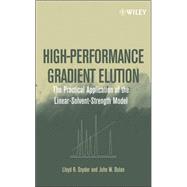
What is included with this book?
JOHN W. DOLAN, PHD, is a Principal at LC Resources. He is author of the popular " LC Troubleshooting" column in LCGC Magazine and coauthor with Lloyd Snyder of Troubleshooting LC Systems.
| PREFACE. | |||
| GLOSSARY OF SYMBOLS AND TERMS. | |||
| 1 INTRODUCTION. | |||
|
|||
|
|||
|
|||
|
|||
|
|||
|
|||
| 2 GRADIENT ELUTION FUNDAMENTALS. | |||
|
|||
|
|||
|
|||
|
|||
| 3 METHOD DEVELOPMENT. | |||
|
|||
|
|||
|
|||
|
|||
|
|||
|
|||
|
|||
| 4 GRADIENT EQUIPMENT. | |||
|
|||
|
|||
|
|||
|
|||
| 5 SEPARATION ARTIFACTS AND TROUBLESHOOTING. | |||
|
|||
|
|||
|
|||
|
|||
|
|||
| 6 SEPARATION OF LARGE MOLECULES. | |||
|
|||
|
|||
|
|||
| 7 PREPARATIVE SEPARATIONS. | |||
|
|||
|
|||
|
|||
|
|||
| 8 OTHER APPLICATIONS OF GRADIENT ELUTION. | |||
|
|||
|
|||
|
|||
|
|||
| 9 THEORY AND DERIVATIONS. | |||
|
|||
|
|||
|
|||
|
|||
|
|||
|
|||
|
|||
|
|||
|
|||
|
|||
|
|||
|
The New copy of this book will include any supplemental materials advertised. Please check the title of the book to determine if it should include any access cards, study guides, lab manuals, CDs, etc.
The Used, Rental and eBook copies of this book are not guaranteed to include any supplemental materials. Typically, only the book itself is included. This is true even if the title states it includes any access cards, study guides, lab manuals, CDs, etc.